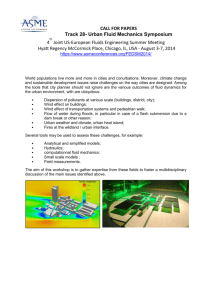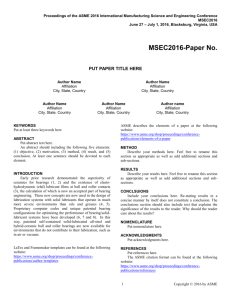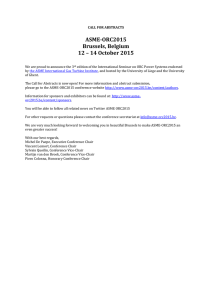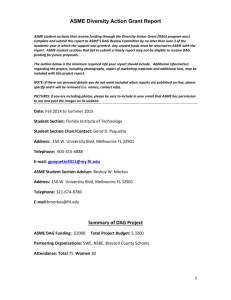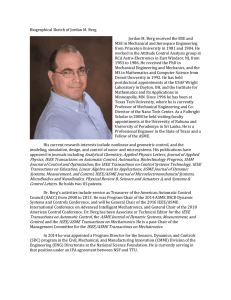Simultaneous Robust Design and Tolerancing of Compressor Blades Please share
advertisement
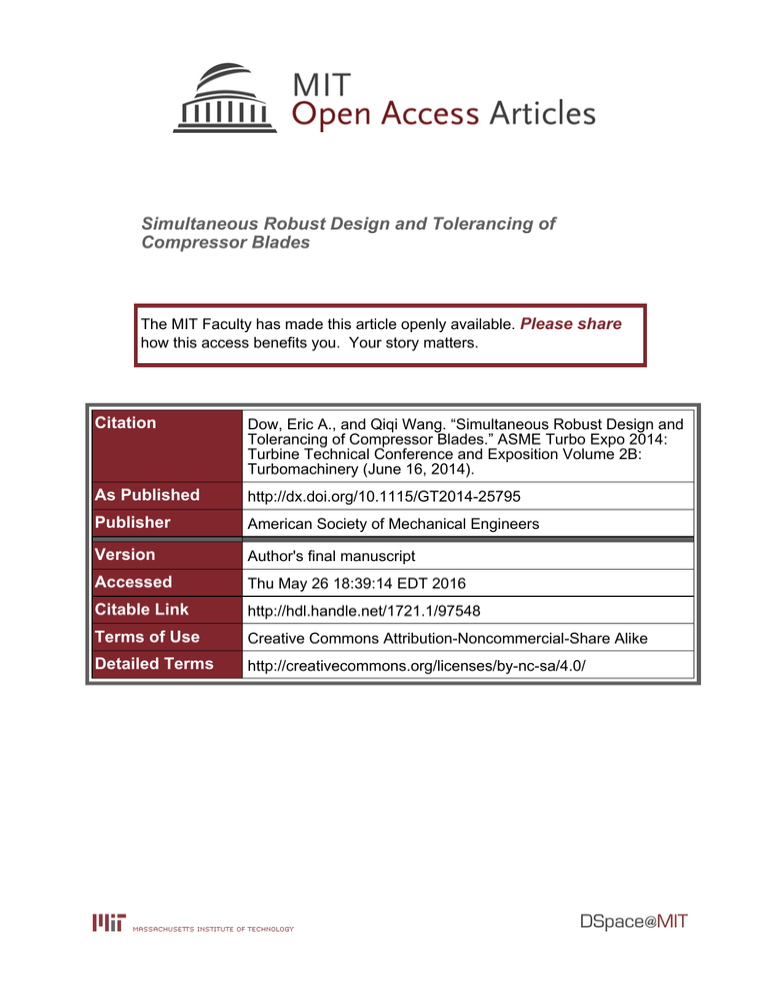
Simultaneous Robust Design and Tolerancing of Compressor Blades The MIT Faculty has made this article openly available. Please share how this access benefits you. Your story matters. Citation Dow, Eric A., and Qiqi Wang. “Simultaneous Robust Design and Tolerancing of Compressor Blades.” ASME Turbo Expo 2014: Turbine Technical Conference and Exposition Volume 2B: Turbomachinery (June 16, 2014). As Published http://dx.doi.org/10.1115/GT2014-25795 Publisher American Society of Mechanical Engineers Version Author's final manuscript Accessed Thu May 26 18:39:14 EDT 2016 Citable Link http://hdl.handle.net/1721.1/97548 Terms of Use Creative Commons Attribution-Noncommercial-Share Alike Detailed Terms http://creativecommons.org/licenses/by-nc-sa/4.0/ Proceedings of the ASME Turbo Expo 2014: Power for Land, Sea and Air GT 2014 June 16-20, 2014, Düsseldorf, Germany GT2014-25795 DRAFT: SIMULTANEOUS ROBUST DESIGN AND TOLERANCING OF COMPRESSOR BLADES Eric A. Dow∗ Graduate Student Aerospace Computational Design Laboratory Department of Aeronautics and Astronautics Massachusetts Institute of Technology Cambridge, Massachusetts Email: ericdow@mit.edu Qiqi Wang Assistant Professor Aerospace Computational Design Laboratory Department of Aeronautics and Astronautics Massachusetts Institute of Technology Cambridge, Massachusetts Email: qiqi@mit.edu ABSTRACT The manufacturing processes used to create compressor blades inevitably introduce geometric variability to the blade surface. In addition to increasing the performance variability, it has been observed that introducing geometric variability tends to reduce the mean performance of compressor blades. For example, the mean adiabatic efficiency observed in compressor blades with geometric variability are typically lower than the efficiency in the absence of variability [?]. This “mean-shift” in performance leads to increased operating costs over the life of the compressor blade. These detrimental effects can be reduced by using robust optimization techniques to optimize the blade geometry. The impact of geometric variability can also be reduced by imposing stricter tolerances, thereby directly reducing the allowable level of variability. However, imposing stricter manufacturing tolerances increases the cost of manufacturing. Thus, the blade design and tolerances must be chosen with both performance and manufacturing cost in mind. This paper presents a computational framework for performing simultaneous robust design and tolerancing of compressor blades subject to manufacturing variability. The manufacturing variability is modelled as a Gaussian random field with non-stationary variance to simulate the effects of spatially varying manufacturing tolerances. The statistical performance of the compressor blade system is evaluated using the Monte Carlo method. A gradient based optimization scheme is used to deter- ∗ Corresponding author mine the optimal blade geometry and distribution of manufacturing tolerances. NOMENCLATURE A You may include nomenclature here. α There are two arguments for each entry of the nomemclature environment, the symbol and the definition. The spacing between abstract and the text heading is two line spaces. The primary text heading is boldface in all capitals, flushed left with the left margin. The spacing between the text and the heading is also two line spaces. INTRODUCTION This article illustrates preparation of ASME paper using LATEX2ε . The LATEX macro asme2e.cls, the B IBTEX style file asmems4.bst, and the template asme2e.tex that create this article are available on the WWW at the URL address http://iel.ucdavis.edu/code/. To ensure compliance with the 2003 ASME MS4 style guidelines [?], you should modify neither the LATEX macro asme2e.cls nor the B IBTEX style file asmems4.bst. By comparing the output generated by typesetting this file and the LATEX2ε source file, you should find everything you need to help you through the preparation of ASME paper using LATEX2ε . Details on 1 c 2014 by ASME Copyright using LATEX can be found in [?]. Instructions for submitting an electronic version of a paper via ftp for publication on CD-ROM or online are given at the URL address http://www.asme.org/pubs/submittal.html. Beautiful Figure FIGURE 1. VERY VERY VERY VERY VERY VERY VERY VERY LONG HEADING If the heading should run into more than one line, the runover is flush left. TABLE 1. TOO. Second-Level Heading The next level of heading is boldface with upper and lower case letters. The heading is flushed left with the left margin. The spacing to the next heading is two line spaces. PAPER NUMBER ASME assigns each accepted paper with a unique number. Replace DETC98/DAC-1234 in the input file preamble (the location will be obvious) with the paper number supplied to you by ASME for your paper. USE OF SI UNITS An ASME paper should use SI units. When preference is given to SI units, the U.S. customary units may be given in parentheses or omitted. When U.S. customary units are given preference, the SI equivalent shall be provided in parentheses or in a supplementary table. F(t)dt + 0+ dg(t) dt Example Time Cost 1 12.5 $1,000 2 24 $2,000 FOOTNOTES1 Footnotes are referenced with superscript numerals and are numbered consecutively from 1 to the end of the paper2 . Footnotes should appear at the bottom of the column in which they are referenced. MATHEMATICS Equations should be numbered consecutively beginning with (1) to the end of the paper, including any appendices. The number should be enclosed in parentheses and set flush right in the column on the same line as the equation. An extra line of space should be left above and below a displayed equation or formula. LATEX can automatically keep track of equation numbers in the paper and format almost any equation imaginable. An example is shown in Eqn. (1). The number of a referenced equation in the text should be preceded by Eqn. unless the reference starts a sentence in which case Eqn. should be expanded to Equation. Z t THE TABLE CAPTION USES CAPITAL LETTERS, FIGURES AND TABLES All figures should be positioned at the top of the page where possible. All figures should be numbered consecutively and captioned; the caption uses all capital letters, and centered under the figure as shown in Fig. 1. All text within the figure should be no smaller than 7 pt. There should be a minimum two line spaces between figures and text. The number of a referenced figure or table in the text should be preceded by Fig. or Tab. respectively unless the reference starts a sentence in which case Fig. or Tab. should be expanded to Figure or Table. All tables should be numbered consecutively and captioned; the caption should use all capital letters, and centered above the table as shown in Table 1. The body of the table should be no smaller than 7 pt. There should be a minimum two line spaces between tables and text. Third-Level Heading. The third-level of heading follows the style of the second-level heading, but it is indented and followed by a period, a space, and the start of corresponding text. f (t) = THE FIGURE CAPTION USES CAPITAL LETTERS. CITING REFERENCES The ASME reference format is defined in the authors kit provided by the ASME. The format is: Text Citation. Within the text, references should be cited in numerical order according to their order of appearance. The numbered reference citation should be enclosed in brackets. 1 Examine (1) 2 Avoid 2 the input file, asme2e.tex, to see how a footnote is given in a head. footnotes if at all possible. c 2014 by ASME Copyright The references must appear in the paper in the order that they were cited. In addition, multiple citations (3 or more in the same brackets) must appear as a “ [1-3]”. A complete definition of the ASME reference format can be found in the ASME manual [?]. The bibliography style required by the ASME is unsorted with entries appearing in the order in which the citations appear. If that were the only specification, the standard B IBTEX unsrt bibliography style could be used. Unfortunately, the bibliography style required by the ASME has additional requirements (last name followed by first name, periodical volume in boldface, periodical number inside parentheses, etc.) that are not part of the unsrt style. Therefore, to get ASME bibliography formatting, you must use the asmems4.bst bibliography style file with B IBTEX. This file is not part of the standard BibTeX distribution so you’ll need to place the file someplace where LaTeX can find it (one possibility is in the same location as the file being typeset). With LATEX/B IBTEX, LATEX uses the citation format set by the class file and writes the citation information into the .aux file associated with the LATEX source. B IBTEX reads the .aux file and matches the citations to the entries in the bibliographic data base file specified in the LATEX source file by the \bibliography command. B IBTEX then writes the bibliography in accordance with the rules in the bibliography .bst style file to a .bbl file which LATEX merges with the source text. A good description of the use of B IBTEX can be found in [?, ?] (see how 2 references are handled?). The following is an example of how three or more references [?, ?, ?] show up using the asmems4.bst bibliography style file in conjunction with the asme2e.cls class file. Here are some more [?, ?, ?, ?, ?, ?, ?, ?, ?, ?, ?] which can be used to describe almost any sort of reference. of the article to the very end as shown in the following example. a = b + c. (2) ACKNOWLEDGMENT Thanks go to D. E. Knuth and L. Lamport for developing the wonderful word processing software packages TEX and LATEX. I also would like to thank Ken Sprott, Kirk van Katwyk, and Matt Campbell for fixing bugs in the ASME style file asme2e.cls, and Geoff Shiflett for creating ASME bibliography stype file asmems4.bst. Appendix A: Head of First Appendix Avoid Appendices if possible. Appendix B: Head of Second Appendix Subsection head in appendix The equation counter is not reset in an appendix and the numbers will follow one continual sequence from the beginning 3 c 2014 by ASME Copyright
